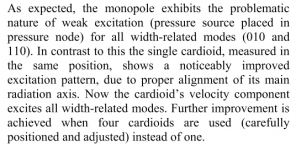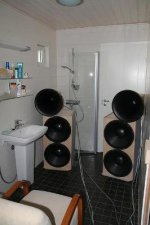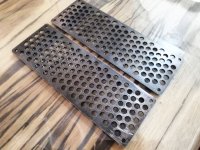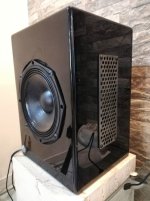It's important to understand why the result shown is occurring and why the monopole isn't responding as well. It is included in the same paper. The position of the sub was as per ITU recommendation for 5.1 home theatre and is not the best position for a single monopole source. Explanation in a snip from the paper below.Here's an image containing frequency response from the Ferekidis, Kempe paper. Single monopole, single cardioid, multi-cardioid.
By placing the speakers in the room to make them work as well as they can and reduce the number of destructive dips the peaks can be controlled well with basic PEQ. It may not be optimal but it can be much better than you are suggesting.In contrast, companies make DIY products (measure yourself and let the computer do the work) using multi-subs that create a flat response.
The point of the LF drivers on the back is to leverage near front wall placement and take account of that through processing. This is a very smart thing to do as most people cannot get far enough away from the front wall to avoid the worst effects from it or have it be absorptive. The 8C arrangement is a practical way to address that reality.I'm not saying bad bass is unacceptable. Humans lived with bad bass in small rooms for decades and no one died from it. But if you're building a D&D 8C then you want to know these things so you can make design choices. Do you try to extend the passive cardioid lower? Do you remove the low frequency drivers from the back and make them independent?
Attachments
Yeah, post #109 is probably the main point. It does take an impressive level of hubris and self admiration to argue with an internationally respected industry expert and tell him "No you are wrong", simply on the basis of what has been written in a few papers... one of them being a students Master's thesis (!)... Considering the number of PhD dissertations I have read in my professional field which were intellectual baby food, sorry if I am underwhelmed. I skimmed through the paper in question, and it's not bad, probably quite a bit above average as engineering master's thesis's go ... but hardly groundbreaking.
Of course we all make our arguments on the basis of facts, as we each individually understand those facts. But we are also making technical judgments when make an argument, and we are asking others to accept our judgment. Thus reputation is an important component of these kinds of discussion. Kimmo's reputation is huge. If I found myself disagreeing with him, my initial thought we be that I have failed to grasp his concept and I need to ask for clarification... I would not go leaping toward my keyboard to gleefully tell him he is wrong... And I actually DO this DIY speaker stuff, as opposed to just reading about it.
Of course we all make our arguments on the basis of facts, as we each individually understand those facts. But we are also making technical judgments when make an argument, and we are asking others to accept our judgment. Thus reputation is an important component of these kinds of discussion. Kimmo's reputation is huge. If I found myself disagreeing with him, my initial thought we be that I have failed to grasp his concept and I need to ask for clarification... I would not go leaping toward my keyboard to gleefully tell him he is wrong... And I actually DO this DIY speaker stuff, as opposed to just reading about it.
Excellent post, hifijim!
Smooth bass response measurement and good subjective sound experiment are not exactly same thing. Movie/multichannel system and stereo for music are not same either.
This thread discussion is not constructive, arguments are not coincident.
When a diy-capable person is considering choices, (s)he makes decisions based on his knowledge, experience and intuition. We usually don't make-believe that we are making the definitely best loudspeaker over and over again. Regarding bass radiator type, we must consider spl reguirement, available space (room) and location of unit(s). Then someone might add also esthetics... like me!
In my opinion, D&D8c is a well educated compromise for a rather compact single unit, giving also some choices regarding installation, with dsp presets and adjustment. I have never ended up to making dipole or cardioid low bass, but use sealed box monopoles as stereo. In my living room they deliver also the .1 channel when watching movies.
Well, for some 10 years I have been intrigued (and asked by eg. S. Linkwitz) about making cardioid or dipole bass units, just for experience and learning. But I don't have four big woofers available for a pair, and no realistic possibilities to let them stay in our living room, even if they happened to sound superior!
Smooth bass response measurement and good subjective sound experiment are not exactly same thing. Movie/multichannel system and stereo for music are not same either.
This thread discussion is not constructive, arguments are not coincident.
When a diy-capable person is considering choices, (s)he makes decisions based on his knowledge, experience and intuition. We usually don't make-believe that we are making the definitely best loudspeaker over and over again. Regarding bass radiator type, we must consider spl reguirement, available space (room) and location of unit(s). Then someone might add also esthetics... like me!
In my opinion, D&D8c is a well educated compromise for a rather compact single unit, giving also some choices regarding installation, with dsp presets and adjustment. I have never ended up to making dipole or cardioid low bass, but use sealed box monopoles as stereo. In my living room they deliver also the .1 channel when watching movies.
Well, for some 10 years I have been intrigued (and asked by eg. S. Linkwitz) about making cardioid or dipole bass units, just for experience and learning. But I don't have four big woofers available for a pair, and no realistic possibilities to let them stay in our living room, even if they happened to sound superior!
with respect to the flow-resistor's construction)
That perforated plate is not much resistive. It looks nicer and keeps plastic foam within the baffles.
I don't wanna interrupt your discussion but to just let you know what I'm up to. I'm getting promising results though it a very difficult job to get it right. I cut two steel mesh using a laser router for the resistive ports to keep resistive material in place. this mesh apparently has an effect on the port response so I'll keep it as is to keep this Variable at bay for now.
Attachments
Relating to the room:
Still, it's principally because of very close proximity. (..dipole near-field.)
Yes, the dipoles are relatively loud in the nearfield but consider this:
"At 50 Hz. it takes almost 40-50 ms. for the brain to even register that a tone at this frequency is present." - Earl Geddes
That's what I was referring to when I said sound travels fast but human perception at low frequency is slow. So, doesn't that mean you need the room? You need the low frequency to stick around a while or you'll run into problems with human processing time. It isn't possible to recognize the signal without fairly long time exposure so you have to rely on the room to keep it around. That's why I was thinking you were effectively damping the room by using less energy but you still need the room.
As I understand it, you raise the quality level to "excellent bass" when the bass exhibits imaging/stereo traits heard in large music halls. And you achieve that in your room with dipole bass positioned correctly relative to the ear and head (nearfield) not relative to to the source location in the room.
If I understand correctly, and properly positioned nearfield dipoles can do that, and future research figures out exactly how it's done then maybe future algorithms will be able to do it with regular low frequency sources.
The point of the LF drivers on the back is to leverage near front wall placement and take account of that through processing. This is a very smart thing to do as most people cannot get far enough away from the front wall to avoid the worst effects from it or have it be absorptive. The 8C arrangement is a practical way to address that reality.
Yes, the 8C is great. But it's better to remove the low frequency sources from the main channels so you can locate them correctly in the room. You can still place individual low frequency sources close to boundaries if you want.
Your front/rear wall reflections only happen in the ray acoustic region (including the transition range where you move from modal to ray). The cardioid in the 8C generates a lot of value in that regard in the low-midrange.
On a side note, Kantamaa included some relevant research to front/rear reflections in his thesis:
"Early reflections in the lateral direction widen the perceived stereo image (Toole 2017). Sagittal reflections can disrupt the stereo image integrity (Ando 1977). Early lateral reflections below 700 Hz affect greatly on the stereo image perception (Angus 2013). Subjects can adapt to large
amount of lateral reflections (King et al. 2011)." - page 21
He did an excellent job including hyperlinks in the PDF to jump to the specific papers, just hover over the citation. His paper is really useful because he compiled recent and relevant research.
one of them being a students Master's thesis (!)... Considering the number of PhD dissertations I have read in my professional field which were intellectual baby food, sorry if I am underwhelmed. I skimmed through the paper in question, and it's not bad, probably quite a bit above average as engineering master's thesis's go ... but hardly groundbreaking.
Of course we all make our arguments on the basis of facts, as we each individually understand those facts. But we are also making technical judgments when make an argument, and we are asking others to accept our judgment. Thus reputation is an important component of these kinds of discussion. Kimmo's reputation is huge. If I found myself disagreeing with him, my initial thought we be that I have failed to grasp his concept and I need to ask for clarification... I would not go leaping toward my keyboard to gleefully tell him he is wrong... And I actually DO this DIY speaker stuff, as opposed to just reading about it.
It's a 2020 masters thesis (i.e. includes citations to recent research relevant to the topic at hand -- cardioid). Maybe you're underwhelmed but I think it's great...and the real kicker was it's from Finland.
I've seen you do DIY speaker stuff. Do you happen to have a link to your DIY cardioid speaker stuff?
The paper certainly offers a nice resume on auditory perception in small rooms. As far as I can judge, the ‘ground-breaking’ only is in the outcome of an ABX (I hope...) test between sources that are nondirectional versus directional at lower frequencies. The room decay and response measurements seem less impressive to me. Although results are obviously true for this specific situation, one has to be careful to generalize the outcome. Both systems display the traditional modal problems and I don’t see that much difference, whereas a good acoustic solution with multiple LF transducers has proven to be beneficial for about one and a half decade now. But there’s no news in that either.
Personally I have some sort of a conviction a cardioid system from about 100Hz upwards, combined with a multisub solution, (still) offers the best bang for the buck. And is aesthetically preferable above huge cardioid or dipole systems, but hey, that’s another story.
Personally I have some sort of a conviction a cardioid system from about 100Hz upwards, combined with a multisub solution, (still) offers the best bang for the buck. And is aesthetically preferable above huge cardioid or dipole systems, but hey, that’s another story.
This is just some 'outside' the discussion perhaps...(literally).... thoughts about experiences with cardioids.
I took a measurement class where subs were setup in a parking lot, and various forms of cardioid deployments were explained how they each work, and then ran.
We measured 360 deg around the various deployments, and listened to each as we walked around them.
It was easy to hear the response changes, the degrees of attenuation, the frequencies of attenuation based on timings/spacings, etc, as we walked around the subs.
It just came down to, exactly where are you trying to reduce response, and at what frequencies
That simple really.
But, in every deployment, and again this was outside with very little boundary muckup via "virtually reflected subs",
there was clearly some loss in frontal bass SQ...
The stronger the cardioid effect, the greater the loss in SQ.
I took a measurement class where subs were setup in a parking lot, and various forms of cardioid deployments were explained how they each work, and then ran.
We measured 360 deg around the various deployments, and listened to each as we walked around them.
It was easy to hear the response changes, the degrees of attenuation, the frequencies of attenuation based on timings/spacings, etc, as we walked around the subs.
It just came down to, exactly where are you trying to reduce response, and at what frequencies
That simple really.
But, in every deployment, and again this was outside with very little boundary muckup via "virtually reflected subs",
there was clearly some loss in frontal bass SQ...
The stronger the cardioid effect, the greater the loss in SQ.
Last edited:
That perforated plate is not much resistive. It looks nicer and keeps plastic foam within the baffles.
-yes, it's not the perforated plate that's adding much resistance (assuming there is enough open surface area), but rather the material between the plates. Still, the perforated plate or "mesh" is often critical to achieve good resistance with typical (lossy non-structural) in-fill material (that's actually doing the resistance).
There are of course other methods to achieve the same result.
Again, the best I've experienced is with a *pleated/corrugated in-fill material (that is itself structural) along with the perforated-plate or mesh on both sides of that material. Similar to many replacement return air filters in overall design.
*of course you have to "play"/adjust the density of the material to get the results you want.
Last edited:
I don't wanna interrupt your discussion but to just let you know what I'm up to. I'm getting promising results though it a very difficult job to get it right. I cut two steel mesh using a laser router for the resistive ports to keep resistive material in place. this mesh apparently has an effect on the port response so I'll keep it as is to keep this Variable at bay for now.
It's your thread, everyone else is interrupting your thread! 😀
The mesh should be fine though typically you want it more "open", but I don't think it should be a problem as long as there is enough surface area open. The entire process is experimental, with a lot of trial to get it correct for your needs.
HOPEFULLY though you've got one on the inside as well: as in a "sandwich" construction (with the in-fill between the plates).
To me though, it still looks like you've got to much volume and the rear of the enclosure is still too far away from the rear of the driver. When looking at the Gradient's midrange: note that it is even "in front of" the magnet.
You can see trial and error (*good measurements) here for various designs/results:
Adventures in cardioid
Post #8 is the good result you want to "shoot" for.
*and it's difficult to get good measurements like these. (..basically you have to do it outside on a stand like MBK is doing it in that thread.)
Last edited:
So, doesn't that mean you need the room? You need the low frequency to stick around a while or you'll run into problems with human processing time. It isn't possible to recognize the signal without fairly long time exposure so you have to rely on the room to keep it around. That's why I was thinking you were effectively damping the room by using less energy but you still need the room.
As I understand it, you raise the quality level to "excellent bass" when the bass exhibits imaging/stereo traits heard in large music halls. And you achieve that in your room with dipole bass positioned correctly relative to the ear and head (nearfield) not relative to to the source location in the room.
If I understand correctly, and properly positioned nearfield dipoles can do that, and future research figures out exactly how it's done then maybe future algorithms will be able to do it with regular low frequency sources.
You don't need the room, humans didn't develop hearing in a room (..and you can certainly hear low freq. and very low freq. outside).
-basically: you are over-thinking this. 😉
No, excellent bass isn't about traits in a large acoustic space.
Instead it's all about the addition of intensity and channel differences achieved with respect to the listener's hearing. It's literally improved channel separation for the listener at lower freq.s. Greisinger (with some of his papers) actually goes into detail with how our ears register those differences.
It's unlikely you could achieve this result without a LOT of processing and a very fixed listening position with a conventional system. IF you had enough sources (mono-pole subs) and proccessing you might be able to achieve something similar in an untreated in-room setting. It's really difficult though when you consider that much past a foot from a source the room typically starts doing some sort of substantive alteration to the emitted soundfield from that source.
This might (though I don't know what the lower freq. limit of the processing is):
3D3A Lab at Princeton University
Technologies – BACCH Labs
Last edited:
The stronger the cardioid effect, the greater the loss in SQ.
Yes, but was it the radiation pattern, or something else (which could even include resulting distortion)?
Multiple sources covering same freq range with same signal...there is always a hit to SQ, at any freq ....
Don't think any type of distortion even enters the question...i think it's entirely about simple combining issues.
Don't think any type of distortion even enters the question...i think it's entirely about simple combining issues.
Last edited:
Mark100, in that field test of subs, was frontal spl response equalized? And was distortion through passband measured? I got the impression that those were large PA subs with very high spl.
Yes, they were high quality PA subs.
And another yes, frontal SPL was equalized as there were four mics set all around letting us read pink noise SPLs, as well as displaying each mic's transfer function.
Then, music was used for audible evaluations.
SPL was very low versus the subs capability, with distortion most likely lower than typically achieved in home audio even at modest levels. Probably under 1%.
A clear takeaway for me (and all who were there i believe), was the stronger the cardioid effect, the greater the impact on SQ.
And another yes, frontal SPL was equalized as there were four mics set all around letting us read pink noise SPLs, as well as displaying each mic's transfer function.
Then, music was used for audible evaluations.
SPL was very low versus the subs capability, with distortion most likely lower than typically achieved in home audio even at modest levels. Probably under 1%.
A clear takeaway for me (and all who were there i believe), was the stronger the cardioid effect, the greater the impact on SQ.
- Home
- Loudspeakers
- Multi-Way
- Resistive port cardioid active speaker insipired by D&D 8C




